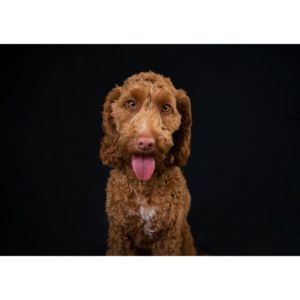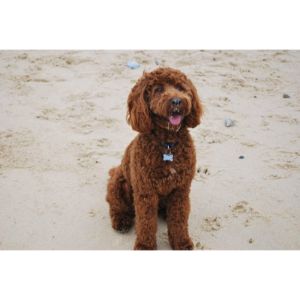
Cockapoos are lovely, fun, and energetic dogs that make excellent family pets. They have sweet temperaments and are great with kids of all ages.
A bonus is that they have hypoallergenic coats, making them an ideal pet for anyone with allergies to animal dander or anyone who prefers a dog who sheds less.
But how do you know if one of these dogs is suitable for your family?
Did you know that there are different varieties of Cockapoo and that the generation they belong to will affect everything from their personality, to their fur coat, to potential health issues they might have down the line?
This article will explain everything you need to know about Cockapoo generations as a whole and then delve even deeper into one of the most popular generations, the F1B Cockapoo.
Suppose everything you’ve read so far about Cockapoo breeding still leaves you with many questions. In that case, this guide will demystify this unique breed and answer any queries about whether one of these dogs will be a good fit for your family and lifestyle.
Ready to learn more? Read on to the first section covering the basics of Cockapoo genetics!
Other articles you would like: Find Cockapoo Breeders Near You and How Often Should I Bathe My Cockapoo?
Table of Contents
Cockapoo Genes: The Basics

At the most basic definition, a Cockapoo is the result of an American Cocker Spaniel and a Poodle or an English Cocker Spaniel and a Poodle that are crossbred.
Many different combinations of potential parents and grandparents result in slightly different dogs, or what are known in the dog breeding industry as generations.
With some breeds, the specific generation a dog belongs to will not have a tremendous effect on their appearance and personality.
This is not the case with Cockapoos, since Cocker Spaniels and Poodles are inherently and genetically quite different from one another.
Some of the most prevalent Cockapoo generations are:
- F1: A Cockapoo whose parents are a Cocker Spaniel and a Poodle
- F1B: An F1 Cockapoo backcrossed to a 100% Poodle (sometimes backcrossed to a 100% Cocker Spaniel).
- F2: A Cockapoo whose parents are two F1 Cockapoos
- F3: A Cockapoo whose parents are two F2 Cockapoos
- F4: A Cockapoo whose parents are two F3 Cockapoos
The FX generations of Cockapoo can go on infinitely, in theory. In the dog breeding industry, the letter F stands for Filial Hybrid, which recognizes that these are not purebred dogs.
The number stands for the generation, with 1 being the first generation, 2 being the second generation, and so on.
You will see some Cockapoo crossbreeds with a letter in their breed name as well, such as the F1B Cockapoo that is covered in this article.
The B stands for “Backcross,” meaning that the dog’s parents are an F1 Cockapoo or a purebred Poodle or Cocker Spaniel. In most cases, Cockapoos are backcrossed with Poodles for their hypoallergenic benefits.
This means that a typical F1B Cockapoo’s genetic makeup will be 25% Cocker Spaniel and 75% Poodle.
It is also possible for a Cockapoo generation to have multiple Bs, such as an F1BB, which means that the breeder has backcrossed the dogs twice.
It is less common to see, but you also may come across an F2B or a second-generation Cockapoo who has been crossbred back with a purebred parent.
When deciding which generation of Cockapoo is right for you, make sure you look for a reputable breeder who you trust and who is transparent about their ethics and breeding practices.
With a non-ethical breeder, you will likely not have to pay as much for a Cockapoo puppy upfront. However, you may have higher costs down the line.
Dogs not only crossbred but inbred tend to suffer from more severe health issues caused by unnatural genetic patterns.
It is for this reason that early generation Cockapoos, such as the F1B, are some of the healthiest and most desirable breeds.
These letter and number combinations are used across the board in the dog breeding industry and will help you recognize the genetic history of any kind of purebred or crossbred dog.
F1B Cockapoo Care Needs

This section will cover some of the basic requirements that an F1B Cockapoo will need from its future family.
Use this information to determine how one of these pups will fit into your current lifestyle or what adjustments you will need to make to accommodate their needs.
How Much Exercise Does An F1B Cockapoo Need?
F1B Cockapoo puppies do not require as much exercise as their adult counterparts.
Like all puppies, they will tend to be hyperactive, and the best way to manage this energy is with shorter and more frequent bouts of exercise, including walks and playtime.
As your F1B Cockapoo grows up, it will require more activity to stay physically and mentally healthy. Most F1B Cockapoos need at least an hour of exercise per day, and most dogs benefit when this time is split into two 30-minute sessions.
Cockapoos are flexible with what kind of exercise they get, and ideally, they will have a variety of different activities to keep them socialized and stimulated throughout the week.
It can be nice to go for a walk around your neighborhood, but the same routine will get dull day after day.
To mix it up, you can take your Cockapoo to a dog park so they can romp and play with other dogs. Cockapoos also do well in homes that have a fenced-in backyard where they can run around and play games like fetch.
Since their genetics are around 75% Poodle, Cockapoos are also highly intelligent dogs. They do well with dog agility and sports that will challenge their minds as well as their bodies!
What Kind of Diet Should An F1B Cockapoo Eat?
Obesity is a growing health issue in the American population, and the same is true for their animals. It can be tempting to indulge your pets with extra treats when their puppy dog eyes are begging for more.
But it’s essential to keep all pets, including F1B Cockapoos, on relatively strict diets that will ensure their long-term health and longevity.
Like all dogs, the amount of food an F1B Cockapoo needs is dependent on its size and how active they are throughout the day. They can eat dry kibble, wet food, or a combination of the two.
Be sure to consult your veterinarian and carefully read the dog food packaging to ensure that it contains all the essential vitamins and nutrients your dog needs.
What Kind of Grooming Routine Is Best For An F1B Cockapoo?

F1B Cockapoos are one of the most popular Cockapoo generations new dog owners look for when they are checking out breeders and puppies.
One of the main reasons for their popularity is because of the hypoallergenic coats they inherit from their Poodle parents and grandparents!
While no dog is 100% hypoallergenic, Poodles (and thus their F1B Cockapoo offspring) are known for being great pets for people with allergies.
They are unlikely to shed all over your house, clothes, and furniture, which is a crucial benefit for many families.
However, because they don’t shed, F1B Cockapoos require regular trips to the groomer to keep their coats and their skin at their healthiest. They will need haircuts roughly every 6-12 weeks, depending on how long you like to keep their fur.
An overgrown coat will carry a lot more dirt and debris can develop mats, which are uncomfortable for your pup and are a pain for you to remove.
Do F1B Cockapoos Have Any Genetic Health Concerns?
As a mixed breed, Cockapoos have a genetic advantage that protects them against many hereditary health issues that are more likely to show up in purebred dogs.
This vitality is known as “Hybrid Vigor,” and it means that hybrid puppies are more likely to be healthier than purebred parents because of a more diverse gene pool.
F1B Cockapoos are technically the second generation because of how they have been back bred and, as such, lose a bit of this protective hybrid vigor.
One of the most common health issues that an F1B Cockapoo might face is hip dysplasia.
This condition is prevalent in both the Poodle and Cocker Spaniel parent breeds and occurs when the ball of the hip does not fit correctly into the socket, leading to joint pain and decreased mobility.
By keeping your dog active and at an appropriate weight throughout their life, you reduce the risk of them developing joining issues, including hip dysplasia.
Other genetic issues that Cockapoos are known for include eye diseases such as glaucoma and progressive retinal atrophy. They are also predisposed to Von Willebrand Disease, which affects the blood’s ability to clot.
While the idea of your dog being sick is a frightening thought, it’s essential to consider the risks and whether you will be able to afford treatment for any of these conditions later in your pet’s life.
Conclusion For “Is An F1B Cockapoo Right For You”

There you have it! This guide to the F1B Cockapoo has covered everything you need to know about this unique generation of the breed, from genetics and hereditary traits, to how you can expect them to look, behave, and fit into your family’s lifestyle.
You will also like:
For more information about the Cockapoo Breed, check out the video below:




